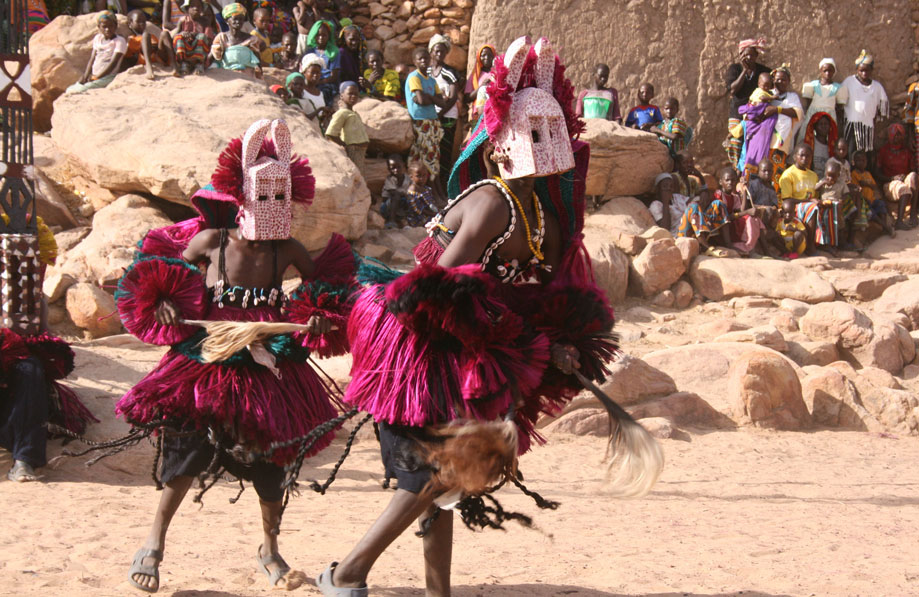To mask or not to mask: Exploring the dynamics of masquerades in African society


This blog was originally posted on the Proofed blog of Boydell & Brewer Publishers on the occasion of the appearance of the book Masquerades in African Society: Gender, power, and identity, co-authored by Walter van Beek and Harrie Leyten.
It started with a conversation on a train. Harrie Leyten had invited me for a guest lecture as part of his course on African Art at Nijmegen University, and we were travelling back to Utrecht. Harrie was going to defend his PhD thesis on ‘African Objects of Power’ two months later at Tilburg University, a study which I had supervised. During the train ride he wondered: ‘After my promotie [the ritual PhD defence], what shall I do?’ I was amused that an 80-year-old PhD candidate – for that would be Harrie’s age at the time of his defence – would worry about a black hole later in his life.
‘I cannot do that alone’, was his immediate answer.
‘Neither can I, so let’s write it together,’ I proposed, and thus the project started, in April 2015, right after his defence.
Mapping masks
Our original aim was to gauge the meaning of masks from their performance in mask rituals; for my Dogon data I had used this angle and the anthropological ritual studies approach seemed to work. In his work as a curator, Harrie approached the object in its own right, a valuable counterpoint. Crucially, during his own African experience in South Ghana Harrie had never encountered masks in the field, which led to a more fundamental question: ‘Why do some cultures have masks while others do not?’ The corollary is: ‘Which cultures?’ In order to answer this question, we needed a detailed map, so we collected all the available reports on African masquerades and plotted these on an ethnic map of the continent. The outcome of that map was a surprise: just three major areas in Africa house masks, and they are not found anywhere else!
The impact of mask rituals on local societies
This is what changed our quest from understanding meaning, to exploring the impact of mask rituals on local societies, and the role of specific arenas on masquerades. A thorough rewrite was called for. Additionally, apart from giving an overview of African masquerades in this fashion, we also investigated the local dynamics of the various societies in question. A different book emerged. One that zoomed in on the social formations that host masquerades, with the ecological and historical background factors that produced the social arenas that formed the fertile grounds for these rituals. We were now answering three basic questions: ‘What sort of societies do house masks?’ and the related ones, ‘What do masquerades do within a society?’ and ‘How do they do it’?
The final product
The final product, Masquerades in African Society: Gender, Power, and Identity, aims to provide exactly what the title says: an overview of those societies that house masquerades, the reasons why these societies – and not others – sport mask rituals, and the three societal arenas that directly inform mask performances, gender and power within the local scene, and identity in the higher echelons. From this angle we explain how masquerades impact their host cultures, and, as a central element of specific rites of passage, derive their meaning and importance from that interaction, with regard to the definition of gender, power configurations, and identity formation.
Bridging anthropology and art history
This is a book for anyone engaged with, or interested in, the fascinating phenomenon of African masking, or the wider relation between ritual and society; as such it is the first extensive anthropological study of African masking, meant to give an eco-social background for the numerous case studies of masquerades on the continent. Anthropology and art history have not always seen eye to eye, and this book tries to bridge that unfortunate divide. On the one hand, we show how the incidences of masking in Africa have a solid eco-social rationale, growing from historical roots that have shaped those parts of the continent where we find masks. On the other hand, from these specific historical and social dynamics an art form has emerged that has regulated life in a great number of African villages, has reshaped the vision Africans have of their own past, and still provides a lasting fascination for those who have bonded with the continent and its colourful cultures.
The book took seven years to come to fruition. Harrie worked on the manuscript until its completion but, sadly, he passed away in 2023 never having seen the book itself.
Would you like to stay updated on new blog posts in the ASCL Africanist Blog? Subscribe here! Would you like to comment? Please do! The ASCL reserves the right to edit, shorten or reject submitted comments.


Add new comment